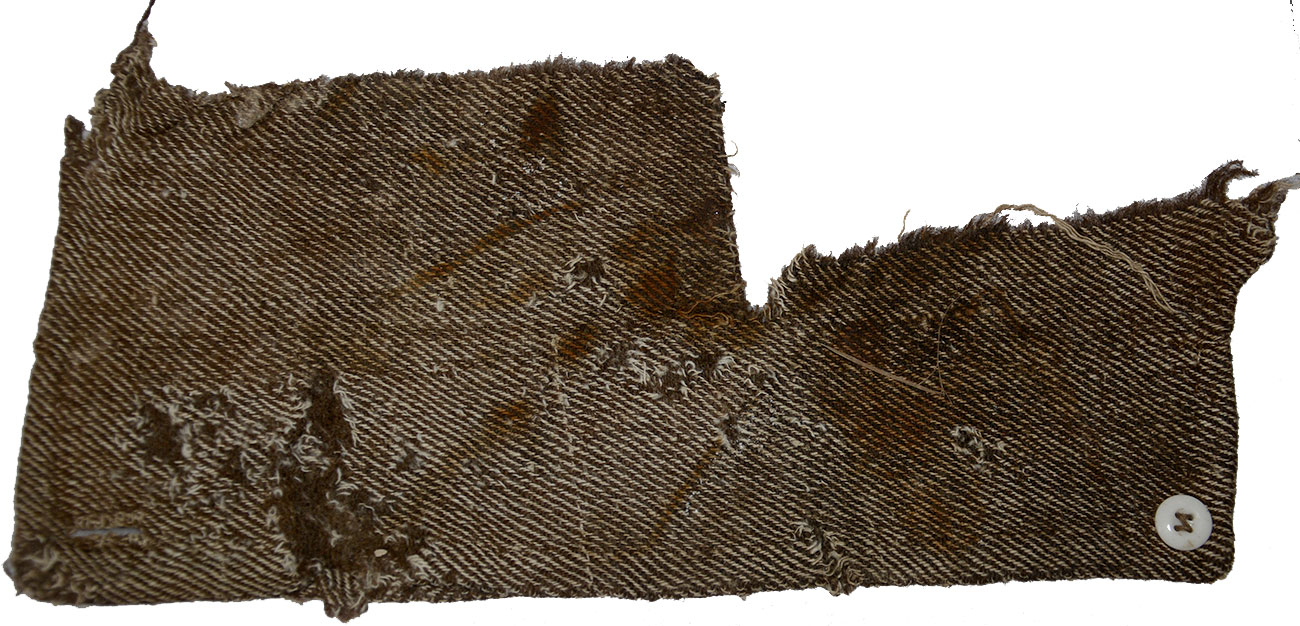site search
online catalog
SHIRT CUFF FROM FORT PEMBINA, NORTH DAKOTA

$225.00 SOLD
Quantity Available: None
Item Code: 1052-601
A relic from a small U.S. Army frontier post of the Indian Wars.
Situated in the Red River Valley in North Dakota near the Canadian border, Fort Pembina was established in 1870 and in operation until 1895. Excavations at the site have produced a remarkable assortment of uniforms and gear from the garrison is surprisingly good shape due to the anaerobic conditions of the dig at what was clearly a dump for the camp, with some material being fragmentary or showing substantial damage, some showing repairs before finally being discarded, and some remarkably complete. The material runs the gamut from the Civil War material used by the army well into the 1870s to very up-to-date issues near the end of the fort’s occupation and everything in between including material issued for trial, very short-lived patterns, as well as commercial and privately purchased pieces a soldier might use in preference to army issue or to preserve it so as not exceed his clothing allowance, etc.
This is a small bit of a soldier’s clothing: remnants of a shirt cuff, still showing the white glass button near the corner. The fabric shows as gray with brown stains. The gray was likely produced by the use of white and black thread with the black oxidizing over time.
Trading posts existed earlier in the area as part of the fur trade, and the first U.S. military post there was temporary- manned by a detachment of Minnesota troops in 1863-1864 following the 1862 Sioux uprising. In March 1870 a new fort was established south of the Pembina River and about 200 yards west of the Red River, completed by July and named in honor of Gen. George H. Thomas. The name was changed to Fort Pembina in September and the initial garrison consisted of two companies of the 20th US Infantry. Their main duty was to provide security for settlers worried about Sioux returning south from Canada, but the troops were more occupied with escorting boundary surveys along the Canadian border and preventing Fenian raids heading north into Canada.
The fort included enlistedmen’s barracks, officers’ quarters, guard house, ordnance storehouse, company kitchen, root house, laundress’s quarters, quarters for civilian employees, hospital and hospital servant’s house, a barn for the “hospital cow,” quartermaster and commissary offices and storehouse, stables, wagon shed, etc. The garrison reached peak strength in 1878 af 200, but the average was about 125 enlisted men and 8 officers. An October 1885 return listed 97 men, 2 field pieces, 1 mountain howitzer, 100 rifles, 19 pistols, 23 mules, and 9 wagons. By 1890 the post had just 23 men, and after an 1895 fire destroyed some 19 buildings it was decided to abandon the fort rather than rebuild, the last detachment left in September. The property was turned over to the Interior Department and later sold in 1902. [sr][ph:L]
~~~~~~~~~~~~~~~~~~~~~~~~~~~~~~~~~~~
THIS ITEM, AS WITH ALL OTHER ITEMS AVAILABLE ON OUR WEB SITE,
MAY BE PURCHASED THROUGH OUR LAYAWAY PROGRAM.
CLICK HERE FOR OUR POLICIES AND TERMS.
THANK YOU!
Inquire About SHIRT CUFF FROM FORT PEMBINA, NORTH DAKOTA
For inquiries, please email us at [email protected]
Most Popular
Historical Firearms Stolen From The National Civil War Museum In Harrisburg, Pa »
Theft From Gravesite Of Gen. John Reynolds »
Selection Of Unframed Prints By Don Troiani »
Fine Condition Brass Infantry Bugle Insignia »
British Imported, Confederate Used Bayonet »
Scarce New Model 1865 Sharps Still In Percussion Near Factory New »
featured item
CIVIL WAR COMMODORE’S UNDRESS FROCK COAT OF SILAS H. STRINGHAM, USN: LEADER OF THE FIRST COMBINED OPERATION OF THE UNION NAVY AND ARMY IN THE CIVIL WAR; VICTOR OF THE BATTLE OF HATTERAS INLET BATTERIES
Fought on Aug. 28-29, 1861, little more than a month after the Union defeat at Bull Run, the capture of Forts Hatteras and Clark on the outer banks helped restrict Confederate blockade running, enabled further operations on the North Carolina coast,… (1179-504). Learn More »




